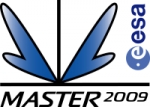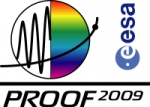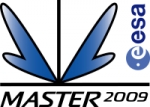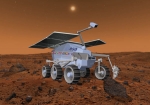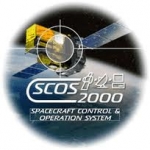Displaying items by tag: ESA
ESA Space Debris Office
The ESA Space Debris Office coordinates ESA's research activities in all major debris disciplines, including measurements, modelling, protection, and mitigation, and coordinates such activities with national research efforts with space agencies in Italy (ASI), the United Kingdom (BNSC), France (CNES) and Germany (DLR). Together with ESA, these national agencies form the European Network of Competences on Space Debris (SD NoC).
ESA's Space Debris Office has also been a forerunner in the definition of a European Space Surveillance System.
ESA's Space Debris Office provides operational services in support of planned and ongoing missions within ESA and to third parties.
ESA's Space Debris Office provides operational services in support of planned and ongoing missions within ESA and to third parties.
MASTER
MASTER (Meteoroid and Space Debris Terrestrial Environment Reference) is a software that can be used to analyze space debris flux and spatial densities. T
he following sources of debris are considered: launch and mission-related objects, explosion and collision fragments, solid rocket motor slag and dust, NaK droplets, surface degradation products, ejecta, and meteoroids. MASTER can deliver flux and spatial density analysis for all epochs between 1957 and 2060. For all epochs, the lower size threshold is one micron. The analysis of the future debris environment is possible based on three different future scenarios (business as usual, intermediate mitigation, full mitigation). The MASTER-2009 software is delivered on a DVD, together with extensive documentation of the underlying models. The software is available for Windows, Linux, Solaris, and MacOS X.
MASTER is developed and maintained by the ESA Space Debris Office.
PROOF
PROOF (Program for Radar and Observation Forecasting) is a software for the simulation of radar- and telescope-based space debris observations.
It is delivered together with the MASTER software. It can be applied for the validation of space debris models like MASTER against observation data. Another use is the planning of debris observation campaigns, including the derivation of neccessary sensor parameters.
PROOF-2009 has been applied in the course of the MASTER-2009 validation process to properly interpret debris observations performed by the ESA Space Debris Telescope, the Liquid Mirror Telescope, the Tracking and Imaging Radar, the Goldstone, and the Haystack Radar. With the new version of PROOF, a simulation of multistatic radar observations, and of phased array radars is now possible.
The software is available for Windows, Linux, Solaris, and MacOS X.
PROOF is developed and maintained by the ESA Space Debris Office.
PROOF
PROOF (Program for Radar and Observation Forecasting) is a software for the simulation of radar- and telescope-based space debris observations.
It is delivered together with the MASTER software. It can be applied for the validation of space debris models like MASTER against observation data. Another use is the planning of debris observation campaigns, including the derivation of neccessary sensor parameters.
PROOF-2009 has been applied in the course of the MASTER-2009 validation process to properly interpret debris observations performed by the ESA Space Debris Telescope, the Liquid Mirror Telescope, the Tracking and Imaging Radar, the Goldstone, and the Haystack Radar. With the new version of PROOF, a simulation of multistatic radar observations, and of phased array radars is now possible.
The software is available for Windows, Linux, Solaris, and MacOS X.
PROOF is developed and maintained by the ESA Space Debris Office.
MASTER
MASTER (Meteoroid and Space Debris Terrestrial Environment Reference) is a software that can be used to analyze space debris flux and spatial densities. T
he following sources of debris are considered: launch and mission-related objects, explosion and collision fragments, solid rocket motor slag and dust, NaK droplets, surface degradation products, ejecta, and meteoroids. MASTER can deliver flux and spatial density analysis for all epochs between 1957 and 2060. For all epochs, the lower size threshold is one micron. The analysis of the future debris environment is possible based on three different future scenarios (business as usual, intermediate mitigation, full mitigation). The MASTER-2009 software is delivered on a DVD, together with extensive documentation of the underlying models. The software is available for Windows, Linux, Solaris, and MacOS X.
MASTER is developed and maintained by the ESA Space Debris Office.
ExoMars
ExoMars (Exobiology on Mars) is a planned Mars mission to search for possible biosignatures of Martian life, past or present. This astrobiological mission is currently (September 2012) under development by the European Space Agency (ESA) with likely collaboration by the Russian Federal Space Agency (Roscosmos).
The program includes several spacecraft elements to be sent to Mars on two launches. An orbiter and a stationary lander is planned for 2016, and a Russian lander to deliver the rover is planned for 2018.
SCOS-2000 software
The Satellite Control and Operation System 2000 (SCOS-2000) is the generic satellite Mission Control System (MCS) software infrastructure developed and maintained by the European Space Agency (ESA/ESOC) in collaboration with European industry
ESA - EAC (European Space Agency)
The European Astronaut Centre(EAC) is a centre of the European Space Agency and home of the European Astronaut Corps. It is located inCologne, Germany, and is sub-divided in to four separate arms, these being Training, Medicine, Education and PR, and Astronaut Management. It provides training facilities to the European astronauts, particularly regarding ESA hardware for the ISS such as Columbus and the ATV. The overall European Astronaut Centre organisation is also in charge of the organisation of the training of European astronauts in the centers of other partners, such as the United States (Johnson Space Center), Russia (Star City), Canada (Saint-Hubert) or Japan (Tsukuba).
The Medical Operations arm (the Crew Medical Support Office) concentrates on providing health related support to the European astronauts and their families. Astronaut management supports and directs the careers and mission placements of the astronauts, and Education and PR are involved in activities related to education and outreach and the appropriate representation of the European astronauts and their space activities to the public.
Mars Express
Mars Express is a space exploration mission being conducted by the European Space Agency (ESA). The Mars Express mission is exploring the planet Mars, and is the first planetary mission attempted by the agency. "Express" originally referred to the speed and efficiency with which the spacecraft was designed and built.However "Express" also describes the spacecraft's relatively short interplanetary voyage, a result of being launched when the orbits of Earth and Mars brought them closer than they had been in about 60,000 years.
Mars Express consists of two parts, the Mars Express Orbiter and the Beagle 2, a lander designed to perform exobiology and geochemistry research. Although the lander failed to land safely on the Martian surface, the Orbiter has been successfully performing scientific measurements since early 2004, namely, high-resolution imaging and mineralogical mapping of the surface, radar sounding of the subsurface structure down to the permafrost, precise determination of the atmospheric circulation and composition, and study of the interaction of the atmosphere with the interplanetary medium.
Due to the valuable science return and the highly flexible mission profile, Mars Express has been granted five mission extensions, the latest until 2014.
Some of the instruments on the orbiter, including the camera systems and some spectrometers, reuse designs from the failed launch of the Russian Mars 96 mission in 1996 (European countries had provided much of the instrumentation and financing for that unsuccessful mission). The basic design of Mars Express is based on ESA's Rosetta mission, on which a considerable sum was spent on development. The same design was also used for the Venus Express mission in order to increase reliability and reduce development cost and time.
ESA - ESAC (European Space Agency)
The European Space Astronomy Centre (ESAC) is the ESA's centre for space science, which means Astronomy as well as Solar System exploration. It is located in Villanueva de la Cañada, close to Madrid in Spain and hosts the science operation centres for all ESA astronomy and planetary missions together with their scientific archives.
Space telescopes are humankind’s eyes in the heavens: from their superior observing positions high above the Earth’s atmosphere, they provide us with astounding views of the Universe. ESAC is where those views are first studied – data on black holes and distant galaxies, from neighbouring planets and even from planets far beyond the Solar System are beamed back to the Madrid countryside. ESAC is thereby the ‘home’ of ESA’s space-telescope and planetary missions, the place from where their science operations are conducted, and where all of the scientific data that they produce are archived and made accessible to the world. ESAC is therefore one of ESA’s centres of excellence for space science. Missions represented a ESAC include (in alphabetical order) AKARI, Gaia, Herschel, INTEGRAL, LISA Pathfinder, Mars Express, Planck, Rosetta, Venus Express, and XMM-Newton.
In addition to deep space and solar system exploration ESAC hosts the data processing of SMOS, a satellite observing the earth, as well as the Space Situation Awareness (SSA) programm.
ESA’s deep-space antenna in Europe, located in Cebreros, Avila, is an essential support to the activities of ESAC. Inaugurated in September 2005, Cebreros features a new, highly accurate pointing control system and a 35-metre antenna that allow ESA to gather data from distant missions to Mercury, Venus, Mars and beyond.
ESAC is also involved in ESA missions conducted in collaboration with other space agencies. One example is Akari, a Japanese-led mission to carry out an infrared sky survey, launched on 21 February 2006. Future collaborative programmes also include the NASA-led James Webb Space Telescope, the successor to the Hubble Space Telescope.
In addition, ESAC also hosts the Spanish Laboratory for Space Astrophysics and Fundamental Physics (LAEFF), an innovative research facility aimed mainly at encouraging young Spanish scientists to enter the fields of astrophysics and fundamental physics.
The ESAC centre in Villafranca del Castillo, within the town limits of Villanueva de la Cañada, is located 30 km west of Madrid in the Guadarrama Valley. Evergreen oaks and the ruins of a nearby 15th century castle make a spectacular backdrop for the high-tech vista of ESA's large antennas and modern buildings. The Cebreros site is in Avila, about 90 km from Madrid and 65 km from ESAC.


